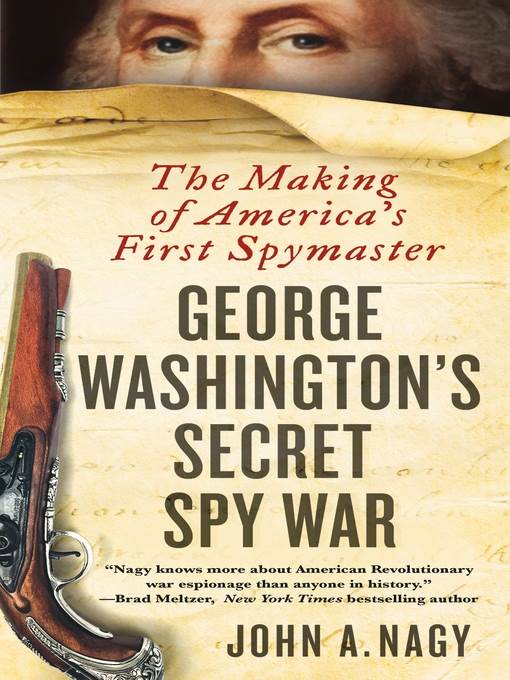
George Washington's Secret Spy War
The Making of America's First Spymaster
- اطلاعات
- نقد و بررسی
- دیدگاه کاربران
نقد و بررسی

August 22, 2016
Drawing on Washington’s correspondence and diary, the late Nagy (Dr. Benjamin Church, Spy), an American Revolution specialist, follows Washington from his participation in the French and Indian Wars, where he cut his teeth in the ways of espionage, to his great deception in the American Revolution that secured colonial victory. Having learned in his 1758 campaign in Ohio that “there is nothing more necessary than good intelligence to frustrate a designing enemy,” Washington used several methods with great success to deceive his enemy in almost every military encounter in which he engaged. He created false troop information; he standardized the means by which his spies gathered information; he and his forces regularly intercepted and read mail; and he used invisible ink in his letters to his own leaders, who had various ways of making the ink visible. According to Nagy, Washington’s greatest tool was the “Deception Battle Plan”: Washington fooled the British into thinking that he would attack the British front line in New York City when instead he moved his troops to Virginia, attacking the British rear flank and securing Cornwallis’s surrender and American victory. Nagy’s fast-paced chronicle reveals a little-known side of America’s Revolutionary War hero. Photos. Agent: Don Fehr, Trident Media.

July 15, 2016
One intriguing, little-known facet of the first general of the Continental Army: his wholehearted embrace of the art of deception against the British.A cryptology specialist of the Colonial period, Nagy (Dr. Benjamin Church, Spy: A Case of Espionage on the Eve of the American Revolution, 2013, etc.), who died this year, found that the Founding Father famed for his inability to tell a lie actually embarked on wartime espionage "with childlike glee." Working with a ragtag army that was no match for the professionalism of the enemy, Washington used espionage to "level the playing field and then exploit it to the best advantage possible." He honed these skills as a young lieutenant colonel working for Gen. Edward Braddock in the war against the French, rebuffing French raiding parties and making allies with the Indians. As war against Britain became inevitable by 1775, Washington, now the Virginia "gentleman farmer" chosen by the Continental Congress to "lead the mob of Massachusetts malcontents surrounding Boston," needed spies to infiltrate British ranks in Boston so he could be prepared for their attacks. One of his methods was to use the observances of local fisherman. Uncovering spies for the British presented another problem--e.g., the revelation of Massachusetts revolutionary leader Dr. Benjamin Church Jr.'s traitorous cipher; he had apparently been playing both sides. On the other hand, an important seeker of intelligence on British positions in New York, young Nathan Hale was caught and hanged by the British as a spy. Washington fed false information to British spies, prepared a standardized set of questions to root out real spies, used misdirection in attacking the British, and promoted the ingenious fabrication of invisible ink. Over several chapters, Nagy effectively lays out Washington's "Deception Battle Plan"--i.e., obscuring where exactly he would attack New York City in 1781, a plan similarly executed so many years later in Operation Overlord (1944) and in Operation Desert Storm (1990-1991). A knowledgeable study of Washington's extensive "bag of tricks" to secure victory.
COPYRIGHT(2016) Kirkus Reviews, ALL RIGHTS RESERVED.

August 1, 2016
This contribution follows recent books and the TV series TURN, based on Alexander Rose's 2007 book, Washington's Spies. The author of three previous books about spying during the American Revolution, here Nagy argues that George Washington, the premier spy master, developed his skill for deceiving the enemy during the French and Indian War, and that Washington enjoyed the deception and was skilled at applying intelligence to his advantage. The narrative delves beyond well-known spies--Nathan Hale, Benjamin Church, Benedict Arnold, and Benjamin Tallmadge--though much of the discussion centers on intelligence activity in New York and New Jersey. Nagy reveals the roles that spies on both sides played to provide information about troop numbers, movements, supplies, morale, etc., which would determine the course of military actions. The most riveting chapters describe the intricate, risky sequence of schemes Washington employed while stealthily moving the American and French armies past New York toward Yorktown to capture Charles Cornwallis. VERDICT Incredibly similar to Nagy's Invisible Ink, which focused on the tricks and tools of Revolutionary War espionage, this book covers much of the same subject matter, and many passages are identical, causing one to wonder if this latest effort was necessary.--Margaret Kappanadze, Elmira Coll. Lib., NY
Copyright 2016 Library Journal, LLC Used with permission.




دیدگاه کاربران